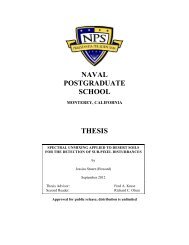October 2000 Newsletter - Naval Postgraduate School
October 2000 Newsletter - Naval Postgraduate School
October 2000 Newsletter - Naval Postgraduate School
You also want an ePaper? Increase the reach of your titles
YUMPU automatically turns print PDFs into web optimized ePapers that Google loves.
RESEARCH CENTER<br />
RAD-HARD SEMICONDUCTOR CHIPS, continued from page 17<br />
Berkeley, University if Michigan and Vanderbilt and national<br />
laboratories such as; NRL, AFRL, NRAD, JPL, NSWC-<br />
Crane and Draper. Over the last 10 years more than 100 NPS<br />
student theses have been related to radiation effects in<br />
electronics. Some students return to the organizations that<br />
require knowledge on radiation effects which provide close<br />
ties with NPS. Much of the student thesis research interacts<br />
with the engineering duty organizations such as U.S. Navy<br />
Strategic Programs, National Reconnaissance Office and the<br />
Space and <strong>Naval</strong> Warfare Systems Command.<br />
Present and Recent NPS Radiation Effect Research Projects<br />
• 1995 – 1999: NPS faculty lead a program with NRL, UC<br />
THE “LINAC”, continued from page 17<br />
Figure 2 is a view of the accelerator taken from the electron gun end. Figure 3<br />
shows the power klystrons and Figure 4 shows the inside of the high voltage supply<br />
for the klystrons, which is also called the modulator.<br />
Early Research Areas<br />
The main interest of Franz Bumiller concerned the structure of deuterium and the<br />
neutron. This was investigated by measuring the angular distribution of electrons<br />
scattered by the deuterium target. These measurements yielded information about<br />
the distribution of charge in the neutron that is probably still valid today.<br />
Later nuclear experiments<br />
with R. Pittham from<br />
Darmstadt, Germany and<br />
collaborators discovered<br />
experimentally the electric<br />
quadrupole collective oscillation<br />
of medium to heavy<br />
nuclei, as predicted by A.<br />
Bohr. These experiments were<br />
--continued on page 50<br />
Figure 2 (above). A view of the<br />
“beamline.”<br />
Figure 3 (right). Three high power<br />
klystrons deliver power to one ten foot accelerator<br />
section.<br />
Berkeley, Motorola, Honeywell and others to develop<br />
semiconductor wafers for high performance GaAs ICs that<br />
could substitute the unhardened bulk GaAs wafer. The<br />
reengineered wafer is transparent to the manufacturing<br />
process, and provides radiation immunity. (Weatherford/<br />
Fouts)<br />
• 1997 – Present: Work has been performed in conjunction<br />
with the University of Michigan’s Center for Ultrafast<br />
Science to measure picosecond / nanovolt resolution<br />
signals internal to the chip. A 100 femtosecond pulsed<br />
laser is used to simulate a “soft error” and provide optical<br />
sampling to resolve electrical signals. This collabortation<br />
--continued on page 50<br />
Figure 4 (above).<br />
High voltage<br />
supply for the<br />
klystrons, which<br />
is also called the<br />
modulator.<br />
NPS Research page 49<br />
<strong>October</strong> <strong>2000</strong>
















